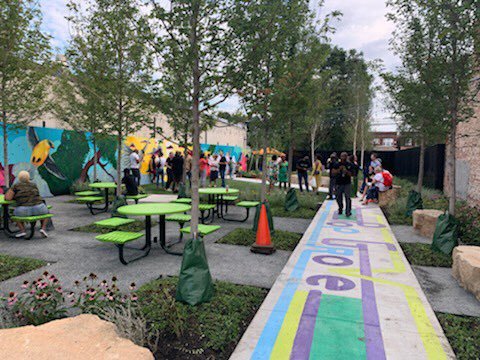ChiBlockBuilder, a platform led by Chicago’s Department of Planning and Development (DPD), streamlines the purchase of city-owned properties and increases the transparency about the land sale process. An interactive online map provides potential buyers with important information about environmental clearances, zoning, square footage, and market value of vacant land available for redevelopment. ChiBlockBuilder’s first round of listed properties closed in February after receiving more than 1,600 applications for uses such as side yards, community open spaces, commercial development, and affordable and market-rate housing.
Chicago’s Environmental Health and Safety Management Bureau (EHS) determined that a proactive bulk approach to environmental assessments was needed to increase property reactivation and/or sale. Before DPD could list the properties, EHS had to conduct environmental assessments for each to determine whether there were potential sources of pollutants in the groundwater or soil. The City of Chicago and its environmental consultants leveraged LightBox data assets. They took advantage of LightBox’s nationwide coverage of Sanborn fire insurance maps and city directories to investigate the history of each property. LightBox sought to help Chicago streamline a massive vetting process and meet aggressive timeframe requirements.

LightBox recently spoke with Paul Waite, an environmental engineer for the City of Chicago EHS, about the project.
Tell us about ChiBlockBuilder and how it got started.
Chicago owns approximately 10,000 vacant properties scattered throughout the city. Vacant lots pose problems that make them hard to develop. Some are brownfields with environmental concerns; some may have been residential properties before they were demolished. In the past, our approach to redevelopment was reactive. When someone was interested in a property, we would conduct a due diligence assessment to ascertain any environmental concerns and determine how to develop the property. About two years ago, the city decided to assess all 10,000 properties in bulk so we could determine which could be made available for sale or reactivation. We wanted to start treating them as valuable assets.
We’re unaware of other cities who have done this amount of due diligence in such a short time. LightBox’s’ (EDR) propriety data viewing tool- Lightbox – was instrumental in the environmental assessment designed by the City of Chicago and our environmental consultants. The Lightbox data viewing application, coupled with industry-leading LightBox EDR government record and historical data, streamlined the data review process and assisted tremendously in bringing these lots to the public. Because LightBox EDR created efficiencies and allowed us to view lots online in bulk, we were able to conduct preliminary due diligence assessments on all 10,000 properties in one year. LightBox EDR was efficient and saved us a tremendous amount of money. We ordered Sanborn maps for almost 100 square miles of the city, and we couldn’t have possibly reviewed that much information during a year without LightBox.
The city uses the results of the reviews to actively market properties to local residents and developers through the ChiBlockBuilder website. After completing the first round, we’re working through the sale process. We hope to hold a second round of property marketing later this year.
Being proactive and having a structured process for tackling the project helped make it a reality. How will you get properties back in the public’s hands in the coming months and years?
After reviewing the properties, we determined that about 45% were eligible for sale, and the rest would need additional environmental review. We initially marketed about 2,200 properties and have received offers or applications to buy more than 1,000.
The city and trusted vendor partners continue to use LightBox data and software to assess the remaining properties. The Sanborn Maps help us look deeper into the records, see the lots in greater detail, and spot any potential red flags. We may order additional city directories to determine what existed on select neighboring properties and whether they pose significant concerns.
This tiered or staged approach to evaluating the properties is significant because it will allow you to investigate a tremendous amount of properties and keep up the pace. Why is this important to Chicago?
It’s an attempt to revitalize neighborhoods that aren’t seeing enough investment from the market. In fact, vacant space is often an impediment to development.
The City of Chicago has worked with the University of Chicago Crime Lab, which studies the effect of vacant lots on local crime on a neighborhood-by-neighborhood and block-by-block basis. Researchers found that redeveloping vacant lots leads to a measurable decrease in crime. Our plan to sell the vacant lots and redevelop them is paying off and will continue to pay off for years.
LightBox’s help was crucial on just about every front. There could be as many as 300 vacant lots in some one-square-mile city sections. With LightBox, we could look at them simultaneously, street by street. It increased the efficiency of the consultants doing the review work. LightBox provided critical tools for evaluating the government database records and the Sanborn Maps. We could custom-order maps for specific addresses, which helped our teams work quickly, and in an organized and logical manner. EDR worked with us to develop new solutions and troubleshooting strategies to help manage reviewing 1,000 properties per month in a steady stream, with few discrepancies.
Chicago’s city directory research/ review process for this project was unique compared to our typical city directory deliverable. They were specific to one address or various versions of an address for the same property, meaning historical addresses. We recognized the turnaround time requirements and the project’s overall scope. We restaffed our production team to meet the requirements for the deliverables, about 150-200 addresses every day, each month. What challenges did you face?
One challenge is that many city areas have been developed since the 1880s. A neighborhood that’s been residential since the 1950s might have been a manufacturing area in the 1920s or 1930s, but that’s been forgotten. Additional due diligence helped us avoid surprises in these cases. Also, when reviewing many properties, it’s easy to treat them abstractly. But with Sanborn Maps, you see a neighborhood’s history and how it has changed over the decades. What might seem like a random lot number in a spreadsheet is shown in the Sanborn Maps to be a real space with a history that impacts the lives of local residents.
ChiBlockBuilder will continue to benefit people directly, one lot at a time. It’s a very rewarding project, and we’re happy to see our work’s results. The dedication and creativity LightBox brought to the process were invaluable—your teams were flexible, quick to adapt, and always ready to help us overcome any roadblocks. We couldn’t have done it without you.
